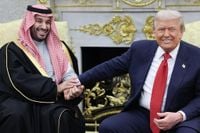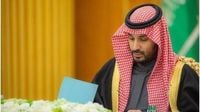Green and white Saudi flags fluttered across Washington, D.C., last week as the city prepared for the arrival of Saudi Crown Prince Mohammed bin Salman (MBS). The occasion was marked by an extraordinary display of diplomatic pageantry: a military flyover featuring F-35 fighter jets, a lavish black-tie dinner, and a star-studded US-Saudi Investment Summit. At the heart of these events was a high-stakes meeting between MBS and US President Donald Trump on November 18, 2025—one that would test the limits of both economic ambition and geopolitical resolve.
According to Axios, the summit was not just about spectacle. President Trump pressed MBS to take a historic step: join the Abraham Accords and normalize relations with Israel. The US had been eager to expand the circle of regional peace agreements, seeing Saudi participation as a potential game-changer for Middle East diplomacy. But the Saudi crown prince stood his ground. As Axios reported, “The Saudi Crown Prince dealt firmly with Trump’s request and held fast to his position.” MBS reiterated Saudi Arabia’s long-standing condition: normalization would only come if Israel accepted a two-state solution, with a Palestinian state based on the 1967 borders and East Jerusalem as its capital.
The conversation, according to US officials cited by Axios, grew tense as Trump pressed the issue and MBS pushed back. The Saudi leader’s response was resolute and clear. During a subsequent press conference, MBS reaffirmed his country’s vision for peace in the region: “The Kingdom seeks peace with Israel, the Palestinians, and the region at large, but only through a clear plan that ensures a genuine path toward a two-state solution.” Riyadh, he emphasized, continues to advocate for an independent Palestinian state as the foundation for any lasting resolution to the Middle East conflict.
While the diplomatic impasse over Israel dominated headlines, the summit also showcased a remarkable convergence of economic interests. The White House heralded what it described as approximately one trillion dollars’ worth of new deals—adding $400 billion to the $600 billion announced during Trump’s Gulf visit in May. Though experts have questioned the math, even a fraction of that sum signals a seismic shift in US-Saudi economic cooperation. The Bulletin reported that “the two leaders took in a military flyover that included F-35 fighter jets; bands played, and Arabian horses escorted the official motorcade.” The guest list for the black-tie dinner and summit read like a who’s who of global business: CEOs from Nvidia, Palantir, Tesla/SpaceX, Apple, and Pfizer mingled with policymakers and investors, underscoring the tech sector’s central role in the new partnership.
At the summit, President Trump made clear that America was “open for business,” personally welcoming many of the attendees by name. The deals announced ranged from artificial intelligence (AI) and data centers to critical minerals and civil nuclear energy. As The Bulletin observed, “Focusing only on the size of the various deals struck in Washington would also obscure how they align not only with Saudi Arabia’s economic development plans but also its long-term strategy of betting on the United States.”
For Saudi Arabia, these agreements are a cornerstone of Vision 2030, the ambitious plan to diversify the Kingdom’s economy away from oil and toward technology, AI, and advanced manufacturing. The Kingdom is already investing $21 billion in data centers, with even greater sums flowing into electric vehicles, space exploration, and renewable energy. Data centers, the backbone of the AI economy, require massive investments in capital, energy, and land—assets that Saudi Arabia possesses in abundance. McKinsey & Company estimates that global data center infrastructure spending will approach $7 trillion by 2030, and Saudi leaders are determined to secure a central role in this new digital landscape.
Energy, too, is a key competitive advantage. Saudi Arabia is rapidly expanding its oil, gas, wind, and solar capacity, and has long eyed nuclear power to meet surging demand. In May, US Secretary of Energy Chris Wright signed a memorandum of understanding with Saudi Arabia’s energy minister on civil nuclear energy. The agreement, formalized in a Joint Declaration in November, establishes a multibillion-dollar nuclear partnership, including cooperation on advanced reactors, uranium mining, and nuclear waste disposal. Wright hailed the deal, saying it “builds the legal foundation for a decades-long, multibillion-dollar nuclear energy partnership with the Kingdom.” However, details about uranium enrichment—a long-standing Saudi goal—remain scarce, raising questions about nonproliferation safeguards.
The critical minerals sector is another pillar of the US-Saudi alliance. Saudi Arabia, believed to have the world’s fourth-largest deposits of rare earths and significant uranium stores, has partnered with US company MP Materials and the Pentagon to build a rare earths refinery in the Kingdom. This move aims to diversify the global supply chain and reduce US dependence on China, which currently dominates rare earths refining. The Economist summed up Riyadh’s ambition: “Saudi Arabia wants to be the Saudi Arabia of minerals.” The Kingdom is also investing $15 billion in mines globally, including in regions where US companies might otherwise hesitate due to political instability or human rights concerns.
But these opportunities come with significant risks. The Bulletin cautioned that “little was said about whether sensitive data would be protected, how technology would be controlled, or even if Saudi Arabia’s long-standing desire for an independent nuclear fuel cycle would finally be realized.” As AI and data center investments accelerate, concerns about cybersecurity, export controls, and the influence of Chinese interests loom large. Human rights issues also continue to cast a shadow over the relationship, with the murder of journalist Jamal Khashoggi still fresh in the minds of many observers.
Despite these challenges, the US administration seems determined to move quickly. The Bulletin noted that “the president elevated [Saudi Arabia’s] status to a non-NATO ally during dinner at the White House,” underscoring Washington’s view of the Kingdom as a critical partner in the race for technological and economic leadership. The administration’s “America’s AI Action Plan,” announced in July, calls for accelerating domestic AI innovation and leading global AI diplomacy—a vision that dovetails closely with Saudi Arabia’s own aspirations.
Not everyone is convinced that the benefits will outweigh the risks. The Bulletin highlighted concerns about regulation and oversight, noting that “the president has noted the need for regulation, but he is not a good ambassador for it. More will need to come from those in the tech sector to whom he listens, and from those who have other channels of influence.” The details of the nuclear agreement, export controls, and data protection frameworks remain to be seen. As the agreements move from headlines to implementation, the world will be watching closely to see whether this new era of US-Saudi cooperation delivers on its promises—or creates new challenges for the region and beyond.
For now, the alignment of interests between Washington and Riyadh is undeniable. With vast sums at stake and the future of technology, energy, and diplomacy hanging in the balance, the deals struck last week could shape the course of US-Saudi relations—and the global order—for decades to come.

